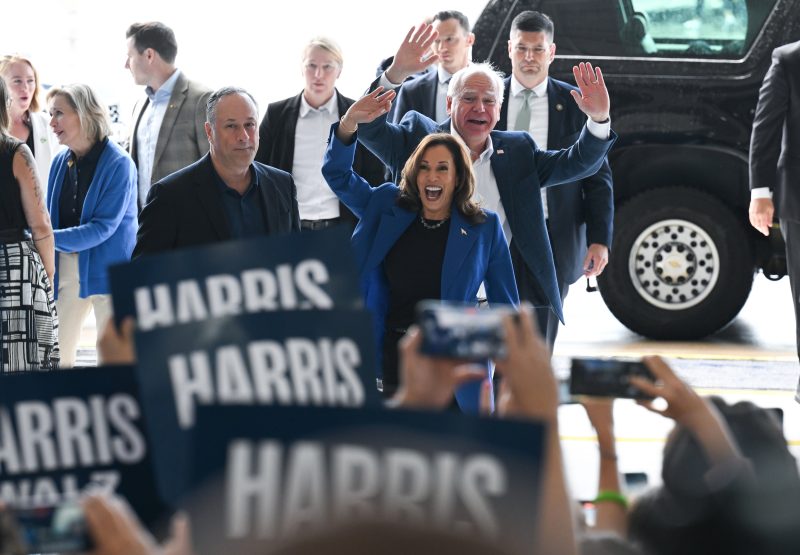
How Harris has largely stayed away from embracing the ‘first woman’ rallying cry
CHICAGO — When Hillary Clinton became the first woman to clinch a major party’s presidential nomination eight years ago, Democratic convention showrunners made sure there was no subtlety in marking the significance of the history-making moment.
Images of the nation’s 44 male presidents appeared on the Jumbotron in Philadelphia beneath the image of a plate of glass that shattered to reveal Clinton beaming in live from New York. “We just put the biggest crack in that glass ceiling yet,” she told attendees at a convention awash in signs and buttons bearing slogans like “I’m with her.”
Eight years later, there will be little outward embrace of a similar history-making moment as the Democratic National Convention gets underway this week in Chicago, even though Vice President Kamala Harris could also become the first female president in the nation’s history. Clinton is slated to speak on Monday night. But the theme of a “potential first” is not slated to be central in this week’s programming — even though some speakers will allude to it — according to two people familiar with the planning who spoke on the condition of anonymity to discuss programming that has not yet been announced.
Harris thus far has stepped gingerly around the subject of gender in her campaign – largely avoiding making it a focal point even as her supporters, running mate and husband often note that they hope to one day introduce her as “Madam President.” Her lighter touch reflects the lessons Democrats internalized from Clinton’s 2016 loss to Donald Trump, as well as their recalibrations after years of watching the former president use race and gender as a wedge to bolster his own political power. The dynamic is also a reflection of Harris’s own historical disinterest in dwelling on the more obvious attributes of her background and candidacy throughout many campaigns in California.
“She’s somebody who at every step of her career has been the first in one way or another – or in multiple ways — but that was something that was always said about her by others, and rarely, if ever, mentioned by her,” said Brian Brokaw, who managed Harris’s 2010 campaign for attorney general in California.
Harris’s strategy draws more historical parallels to the one that Barack Obama adopted when he ran for president in 2008. Though his supporters reveled in the excitement of electing the first Black president, his message was always focused on the future, his plans for the country and the inclusive messaging that he would be a president for all Americans. When reporters would press him on the significance of becoming the first Black president, Obama would sometimes note that he was proudly of the Black community but not limited to it as he ran to be president of the entire United States.
David Axelrod, Obama’s long-time strategist, said that the team’s theory “was always that you get all that for free — people can see; they don’t need a roadmap to figure that one out.” Axelrod added that “there are people who might be available to you for whom that’s not an incentive, or who may feel excluded if you make that focus.”
Axelrod argued that the focus on Clinton’s gender in 2016 was limiting: “It diminished her to turn her into a symbol.”
“This we were very conscious of,” Axelrod added of the messaging in Obama’s campaigns: “Elections are not about you, they’re about everyone else. What you want is for people to feel like you are connected to their lives and you are going to work for them.”
In her sprint to Election Day after President Joe Biden withdrew from the race, Harris has introduced herself to Americans as a former prosecutor, district attorney and attorney general of California who knows Trump’s “type” from her years in the courtroom. As she has run against Trump – who has a long history of attacking his female rivals with misogynistic tropes – she has avoided addressing his critiques on her intelligence, his suggestion that world leaders would view her as “a play toy,” or his questioning of her racial identity as a Black and Indian woman.
Her stump speech rather frames the race as a fight for fundamental freedoms, including restoring abortion rights that were rolled back by the Supreme Court decision overturning Roe v. Wade. She draws the most applause at her rallies with a line that encapsulates Democrats’ desire for a new generation of leadership and their hopes of turning the page from Trump: “We’re not going back.”
Though Harris is not explicitly making the case in her stump speech that Americans should elect the first female president, her campaign is capitalizing on the excitement around that prospect. The official store of the Harris-Walz campaign sells a $47 T-shirt designed by Cleo Wade with an image of a young Harris beside the words “The first, but not the last.” Her supporters have raised millions of dollars on fundraising calls that were organized by “Black women for Harris” or “White women for Harris” (as well as calls organized by White and Black men).
The focus on her credentials and her agenda is consistent with how she ran her past races where she seemed intent on ensuring that questions about her race and gender did not become a distraction. Brokaw remembered walking with Harris to a briefing at the California Department of Justice when she was running for attorney general through a long hallway hung with portraits of all the men who had held the job. She was clearly taking note of that visual, he said, but felt no need to call attention to it aloud.
“I have no doubt that she was very much aware of the many firsts she’s accomplished along the way, but I don’t think that’s what drives her,” Brokaw said. “If anything, it’s maybe the doubts that have been sowed by people because she doesn’t fit the mold – that’s what probably fuels her more than the idea of being the, quote, first.”
Several of Harris’s former aides recalled with amusement that when asked how it felt to be the first woman of color elected to hold a certain office, Harris would sometimes quip that she wasn’t sure how to answer because she’d always been a woman and a woman of color. She fiercely championed the cause of abortion rights as vice president and has often made a point of talking about how her life experiences and her advocacy on behalf of women – prosecuting crimes against women and children, for example, or trying to eliminate inequities in Black maternal health – have shaped her perspectives on policy.
But she has also been quick to remove gender from the conversation when she thinks it is irrelevant. Debbie Mesloh, a longtime Harris confidante, noted that during her U.S. Senate race in 2016, Harris would recount the many times during her career when she had arrived at events and would be asked to talk about issues important to women.
“She’d be like, ‘Oh good, you want to talk about the economy; you want to talk about climate change?’” Mesloh said. “Her approach was that that was a false choice. It’s all women’s issues.”
As a woman running for offices such as district attorney or attorney general that had always been held by men, Harris’s campaigns reflected the fact that voters had specific criteria they were looking for because the jobs were so closely tied to public safety, said longtime California Democratic strategist Rose Kapolczynski.
“There’s a high standard to meet to prove that you not only share their values on crime and safety issues, but that you are competent to carry those out,” said Kapolczynski, who ran former Sen. Barbara Boxer’s four campaigns in California. “That’s where I’ve seen Harris focus — on competence and experience, and that message still works today against a Donald Trump.”
Aimee Allison, the Oakland-based founder and president of She the People, an organization that aims to elevate the voice and power of women of color, said the Harris campaign has also made a very conscious effort to excite and organize women of color than past cycles. That is in part, she said, because one of the lessons of 2016 was “that the ‘women’s vote’ wasn’t the ‘women’s vote.’” White women favored Trump over Clinton, while Black and Hispanic women overwhelmingly backed Clinton.
“We’re at the moment where it isn’t enough to argue to the American population: ‘Hey, vote for someone because of their race or gender or any other identity,’” Allison said. “The issue is, what do you know? Who do you move? What do you stand for? Who are you bringing along?”
Karen Finney, a Democratic strategist who advised Clinton, noted that the former secretary of state’s candidacies in 2008 and 2016 – as well as women who ran for the White House after her, such as Democrat Elizabeth Warren and Republican Nikki Haley — helped voters get more accustomed to the idea of a woman at the top of the ticket.
“I don’t think you can have a Kamala without a Hillary, because [Clinton] broke a lot of barriers and norms,” Finney said. “Part of what has changed – or is evolving – is that women can be themselves [as candidates]. There’s still definitely things women leaders have to prove – like are they tough enough. But now that we see more women in places of leadership – in the Senate, in Congress, in Fortune 500 companies – it’s been normalized across the culture in a lot of ways that are very meaningful.”
For years, when asked about the groundbreaking nature of her electoral victories, Harris would steer the conversation toward the importance of mentorship. She would quote her mother Shyamala Gopalan, a scientist and breast cancer researcher, who often told her: “You may be the first. Don’t be the last.”
